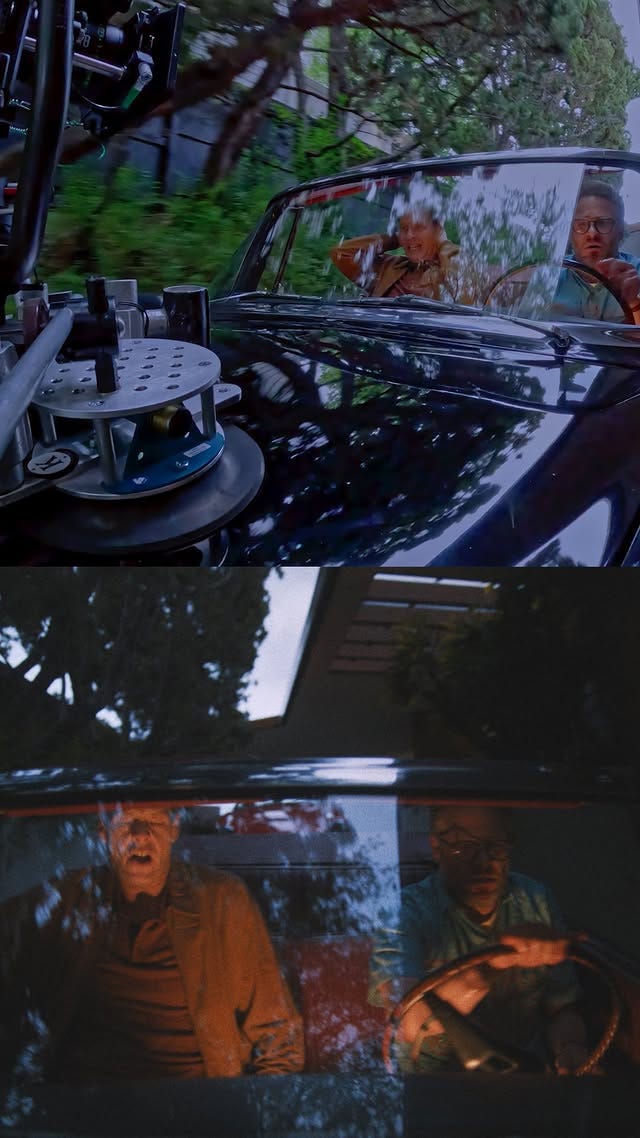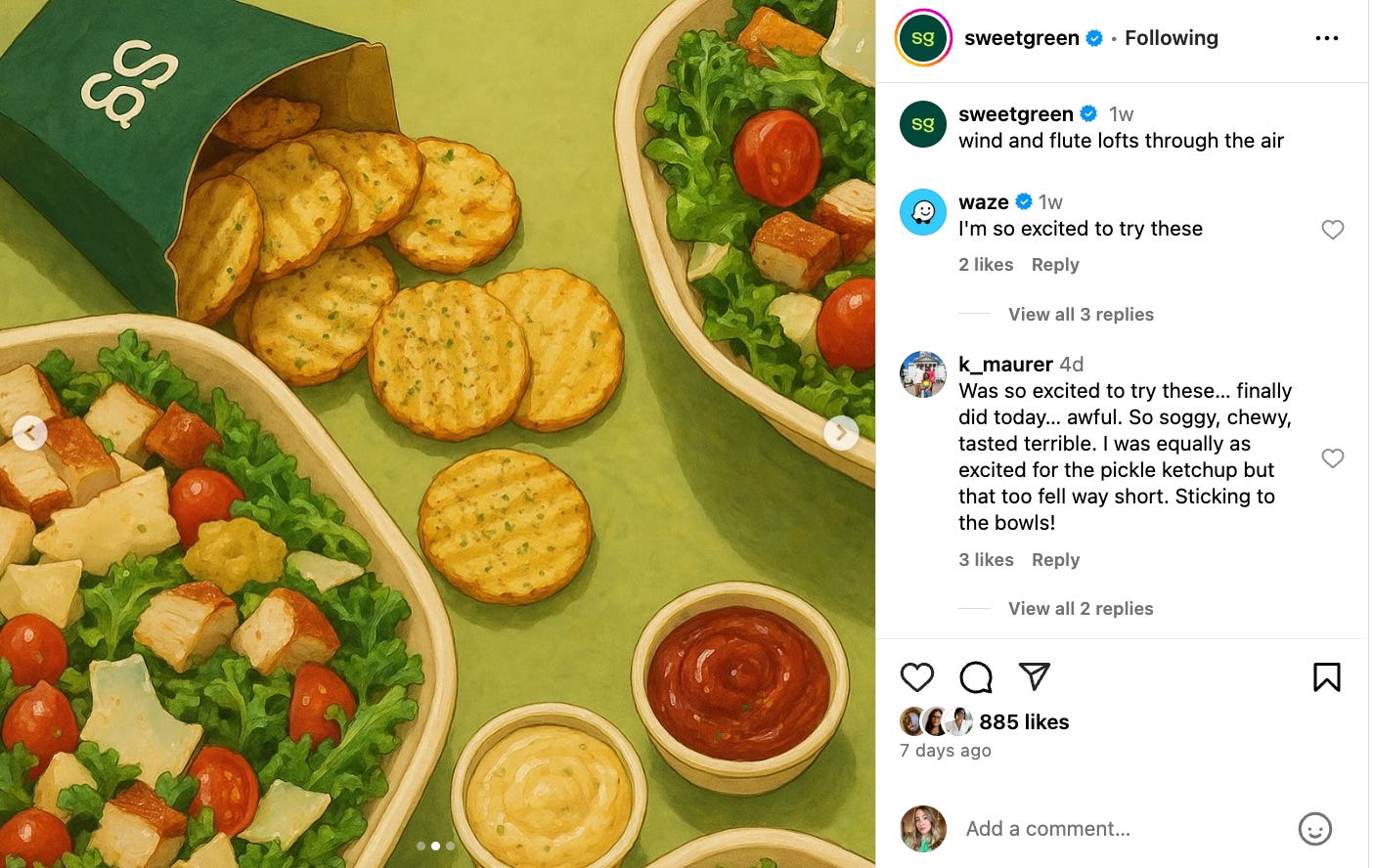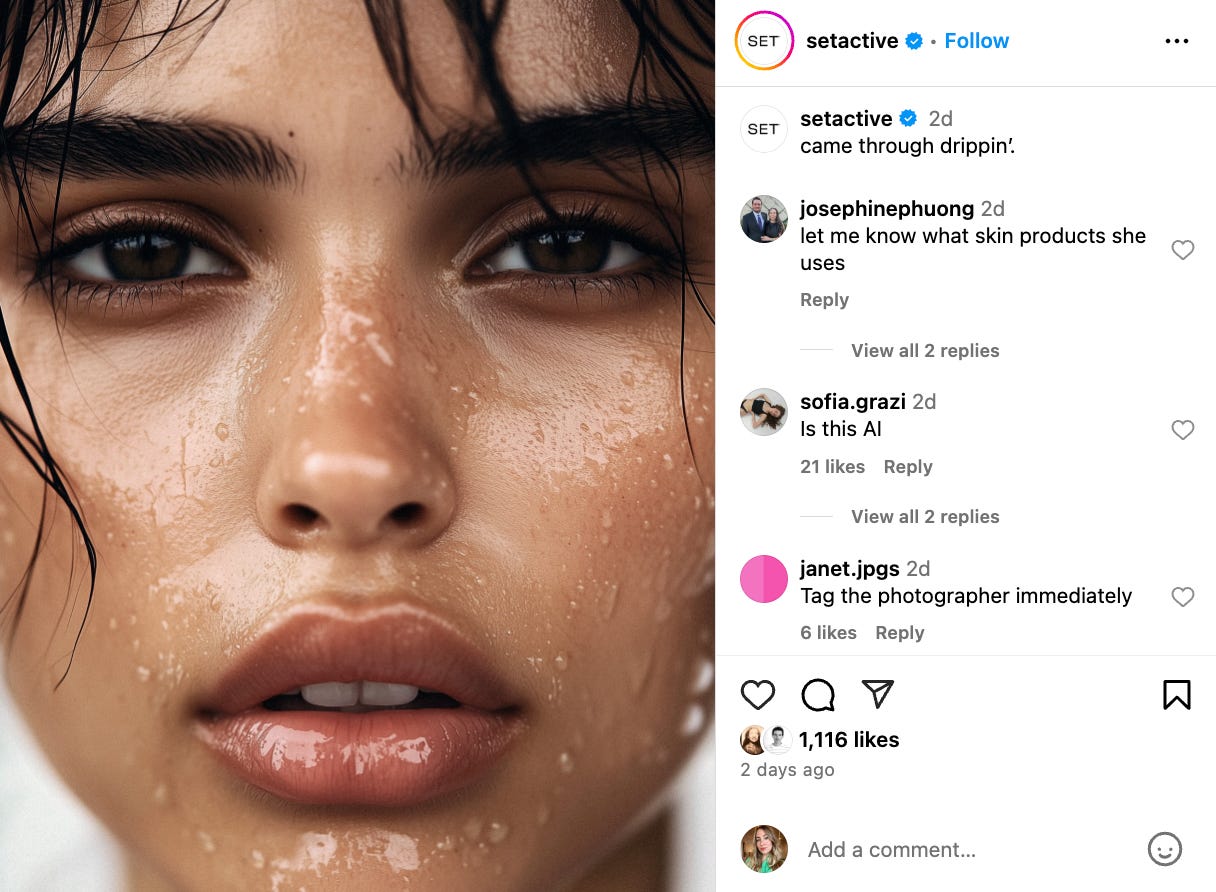Why AI Will Lead to More “Proof of Reality” Posts
AI won't be the biggest trend on brand social. The reaction to it will be.
One of the most-liked photos on activewear brand SET Active’s Instagram in March was likely made using Midjourney. Despite the campaign being passed around marketing circles when it launched, I’m embarrassed to say I didn’t clock the photo might be AI until I heard their Chief Brand Officer mention it on TikTok. None of commenters seemed to notice either—with many touting it as “SO GOOD”.
This is a shift.

Up until now, images and videos generated using AI have been perceivable to the average social media user. When brands would dabble with AI on social, like Crown Affair here and Balenciaga here, the comments would call them out, saying things like “AI is a cop out” and “Girl...”. But as AI tools get better at mimicking reality—like we saw last week with OpenAI’s 4o Image Generation roll out—that comment section sentiment will inevitably lighten. Management will begin asking What’s our AI visual strategy on social? It’s already happening.
It would be easy to say that I think AI is going to be a big trend on brand social in the next year. The reality is, it’s the reaction to AI that will be the even bigger trend. As some brands slopify themselves, it will be the ones that invest even deeper in good creative that will stand out. With this, we’ll see a rise in what I am calling “proof of reality” posts—videos, images, and captions that clarify how specific creative was made.
“Proof of reality” posts
A few weeks ago, I was reading a conversation about AI between Elizabeth Goodspeed, independent designer and US Editor-at-Large for It's Nice That, and creative studio PlayLab. Elizabeth brought up a tactic that popular film photographers like Irving Penn and Henri Cartier-Bresson would employ to show the image hadn’t been altered. They would leave the borders of negatives in the final photo to show that they composed the shot in camera, rather than relying on post-production tricks like cropping it down in the darkroom.
After learning about this, I wondered what the “showing the borders of negatives” would be for social media as AI continues to gain popularity. Once AI-generated images become imperceivable, how would brands signal that they don’t use it?
I predict we’ll see more posts like Apple TV’s BTS of how their camera operator got a very impressive shot in The Studio. Chamberlain Coffee captioning how their claymation campaign came together with “handcrafted, just like our coffee.” Topicals simply tagging every single creative who worked on a video. It will become social media currency for the brands that abstain from using AI in creative to share their “proof of reality”. The polite way of saying “AI could never”.
Wait, but why would brands not want to be associated with AI images and video?
To explain why brands will want to show “proof of reality”, it’s important to explain why brands might not want to be associated with AI creative in the first place.
Brands that use AI images or videos on social—whether perceivable or not—are making a statement to the consumer about craft. If your brand cares about how your product is made, then it would seem incongruous to use AI to mimic the style of a maker. For example, it surprised me when Sweetgreen—a company that highlights farmers and well-sourced ingredients—participated in the Studio Ghibli trend. As Elizabeth told me, “AI usage communicates a lack of investment or care to me—either in budget, time, or creative team infrastructure. Viewers care about how things are made, even if they don’t always know how to articulate it. If a brand can’t be bothered to write its own product detail page copy, why should I trust they’ve vetted their ingredients? If they’re outsourcing their social content, what else are they cutting corners on?”
When I asked Chelsea Kyle, a photographer and director who often works with brands, about this, she pointed to the collaboration that happens on set and what brands might be missing when they use AI. She told me, “It goes without saying that one of the best parts of this job is collaborating with humans, and making decisions together based on an amalgamation of studied skill sets and passions. I think a huge misconception that has always existed is that good creative is made by only one really talented artist/photographer/designer/creative, and that AI is just going to replace those roles. I have found that my most successful projects come from good collaboration with clients/creatives/producers. They know their strengths as a collaborator, have spent the time thinking about what they want, and are prepared to communicate their vision and where they need help.”
What will get tricky is when audiences aren’t able to tell if something was made with AI in the first place. When I asked Nikita Walia, Strategy Director at brand and venture studio U.N.N.A.M.E.D., about what it feels like to find out a post was made with AI, she told me, “I do feel differently when I find out something was AI: not because it looks worse in retrospect, but because it reveals the larger tension—this pressure to produce content endlessly, faster, cheaper. AI isn’t the root cause, it’s a symptom of a system built on endless production and efficiency at all costs. AI is just the latest workaround to feed the machine of infinite growth. And the cost is often invisible: creative jobs, artistic development, long-term brand value. I have a hard time moralizing it, because it seems inevitable. Every new technology brings a power and paradigm shift, it’s up to us how we negotiate it.”
Image generation for brainstorming vs posting
I’ve already heard from multiple social media managers that their bosses are asking how they plan to AI images into their strategy. There’s one way that seems to be the consensus among experts I spoke to about this: brainstorming.
Elliot Vredenburg, Creative Director at U.N.N.A.M.E.D., told me “AI is most valuable behind the scenes. It’s very useful in moments where sketches matter more than polish. It can help brainstorm faster, explore more directions, and pressure-test ideas. That’s exciting! But it works best when it’s a collaborator, not a replacement. When you try to skip past human involvement, things get emotionally hollow. It may be subtle, but people can feel the difference—and the extractive quality is evident to many as well.”
I’ve seen AI image generation used to sell through big ideas, mock up what an activation might look like, and iterate on a brand mascot’s costume. Even big creative studios like PlayLab use it. In their interview with Elizabeth, they said, “For Post Malone’s F-1 Trillion, we had the idea to invert a truck and suspend it over water, inspired by Gonzalo Lebrija’s work. To get Post and his team on board, we used AI to communicate the idea—knowing people might assume it was artificial. But when they learned it was a real commission, that Lebrija stripped the truck and sent it back to Nashville after it hit the water, it became something else. Then you see the photo, right before impact, and it gives you chills. No AI could do that.”
It’s clear that AI can help sell through real, big-budget creative ideas. As Nikita succinctly put it: “The point isn't to replace creative process: it’s to deepen it.” AI shouldn’t be the posts, they should power the posts.
What’s next? (I don’t know)
While writing this, I’ve been thinking a lot about Succession. The series was primarily shot on film. As an average viewer, did I notice it? Not really. Still, I ate up every story about changing the roll every ten minutes and how the film coloring contributed to the mood. These facts contributed to my overall sentiment about the show—knowing how intentional they were with filming made me believe every other decision within the show must be equally exacting. Quality creative has a halo effect. Effort has a halo effect. “Proof of reality” has a halo effect.
I know that every brand has a different tolerance for AI. I’d imagine the ones screaming into microphones on TikTok Shop livestreams every day might be more willing to sacrifice quality for efficiency. It’s still unclear how far AI will be pushed and I’m probably going to be proven wrong on a few points in here—but in Joshua Rothman’s recent piece in The New Yorker he writes, “There’s no longer any scenario in which A.I. fades into irrelevance. We urgently need voices from outside the industry to help shape its future.” Maybe this is my small attempt to do that.
For a lot of the brands that read this newsletter, there’s an appetite to continue showing up in clever ways online. Followers are more aware than ever that they are being sold to—with top comments on posts often saying “Best campaign of 2025” and “Now this is marketing”. These “proof of reality” posts will be used by brands to signal to consumers that they care.
As Elizabeth told me, “I think using AI removes the ability to be surprised. By nature, it remixes what already exists. It’s never ahead of the curve, it just packages trends more efficiently. So the more brands that rely on it, the more homogenous everything starts to feel…You can’t build brand distinction off something—a concept, a tool, an aesthetic—that’s accessible to everyone. You have to find it yourself.”
You can support free essays like this one with a paid Link in Bio subscription!
It’s likely an educational expense at your company—here’s a template for you to use when asking your manager. I personally think the Discord is worth the subscription alone. Here’s what one person said about the community: “The Link In Bio Discord has easily become one of the best tools to have in my arsenal working on social each and every day. It's so rare to find such a connected community that just GETS it and will answer any and all questions at any hour of the day.”
Finally, you can catch me answering lots of social media questions in today’s edition of Feed Me! Read it here.









LOVE this analysis. Thank you for putting into words what I’ve been trying to articulate with other creative friends!
Thank you Rachel! So awesome to be included in this extremely thoughtful analysis. Humans creating rad shit>